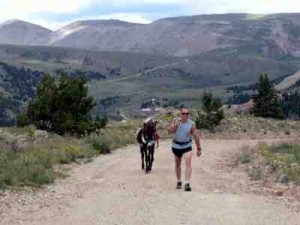Column by Hal Walter
Mountain Life – January 2006 – Colorado Central Magazine
THERE HAVE BEEN YEARS, certainly, when I’ve managed to keep the corrals pretty clean all the way past the Winter Solstice. This isn’t one of those years.
It gets away from you quickly and quite silently, the same way deer steal alfalfa hay left out under the cold moonlight. You skip a couple of days for one reason or another. Then it’s your day to watch your son and it’s too cold to bring him outside while you work. Thereupon, perhaps something else like work or a minor illness gets in the way of progress. At this time of year if you let it go more than a week you probably won’t see dirt until March. But rest assured your multi-layered manure glacier of snow, ice and digested hay will remind you it is there with a particular rural smell during warmer spells in January and February.
In this case the manure, roughly half of it placed there by actual world champion pack-burros who have made more money at their trade than some writers I know, began to pile up along with the various work I do to make a living. This is an irony because I honestly would rather shovel shit than do some of this work. Then came cold temperatures. Then the “viral gastroenteritis.”
It started with our son, Harrison. Everything was fine one minute, and the next thing we knew he was projecting vomit all over the living room furniture and carpet, and we were calling to cancel the babysitter we had lined up so that we could go to a neighborhood Christmas party. Two days passed before my wife came down with the virus, puking at stopping points along Highway 96 as I drove her home from an eye exam in Pueblo.
A few hours later I woke up at precisely 1:18 a.m. with the tell-tale watery mouth that says, “Hey buddy, you’re about to hurl. Better get out of bed.”
I’ll spare the details except to say that I was blowing something, not snot, out of my nose for the rest of the night. The next day I spent almost entirely on the couch, as the coldest weather of the year rolled in bringing subzero temperatures.
Several of us in the area have late-season private-land only elk licenses good for the month of December. It was a certainty that the weather would bring in a herd. The day following my long couch ride I worked up enough energy to take a look around. The entire recovering family pulled on layers of clothes and piled in the truck as we went out to scan the nearby ridges.
We easily found two cow elk grazing several hundred yards up a hillside in the middle of the afternoon, but it did not escape me that the mercury had been hovering at about 1 degree when we left the house. I looked at the elk and then passed my binoculars to my wife. “My hands hurt just thinking about it,” I said.
We went home.
A few hours later, just before dark, my friend Kevin shot one of those two elk. Then came word that two other guys had also been successful. Now I practically had the entire range to myself, and by most counts there were at least 300 head of elk milling around the neighborhood.
But work beckoned. Bringing home the bacon would stall the quest for meat for a few more days. And then it was time to cut a Christmas tree.
And then we had visitors. In all honesty I still didn’t have the strength or stomach for hunting an elk anyway, and the shit, frankly, was piling up.
RECENTLY I learned a point of earth science that I had previously not considered. Though the days continue to get shorter until the solstice around December 21, the sun actually starts setting later in the day about two weeks earlier in December — this year the earliest sunset was on December 7.
(For a full explanation go to: http://www.larry.denenberg.com/earliest-sunset.html.)
One brilliant December day I picked up a shovel and a rake, rolled out the wheelbarrow and went to work. Some of the manure was fresh, some of it old and powdered, and some of it was frozen. I raked and scraped and scooped. I broke manure ice. I uncovered loose trail apples completely enshrouded in frost. I rolled several wheelbarrows through the snow to the “shit pit.” I was making real progress.
A waxing gibbous moon, about 87 percent illuminated, stood in the eastern sky while I worked under an unlikely December sun which at this point was showering the entire landscape of snow, rock, trees and mountains with an eerily fantastic light. At one point I seriously considered stripping to just a T-shirt as I worked up a sweat. Instead I merely pulled up my sleeves and went back to work, finishing one corral and moving on to the next.
And then, like someone had flipped a switched, the sun slipped behind the ridge to the west, the same ridge where we saw the elk a few days ago. The warmth dissipated almost immediately and I sought a jacket. The corrals were nearly clean — only one frozen patch remained when I called it quits.
Perhaps the next day I could complete the task, getting a shovel ahead of a chore that one can never stay ahead of for very long.
Or maybe I’d go hunt for an elk.
Hal Walter writes and shovels from the Wet Mountains.

